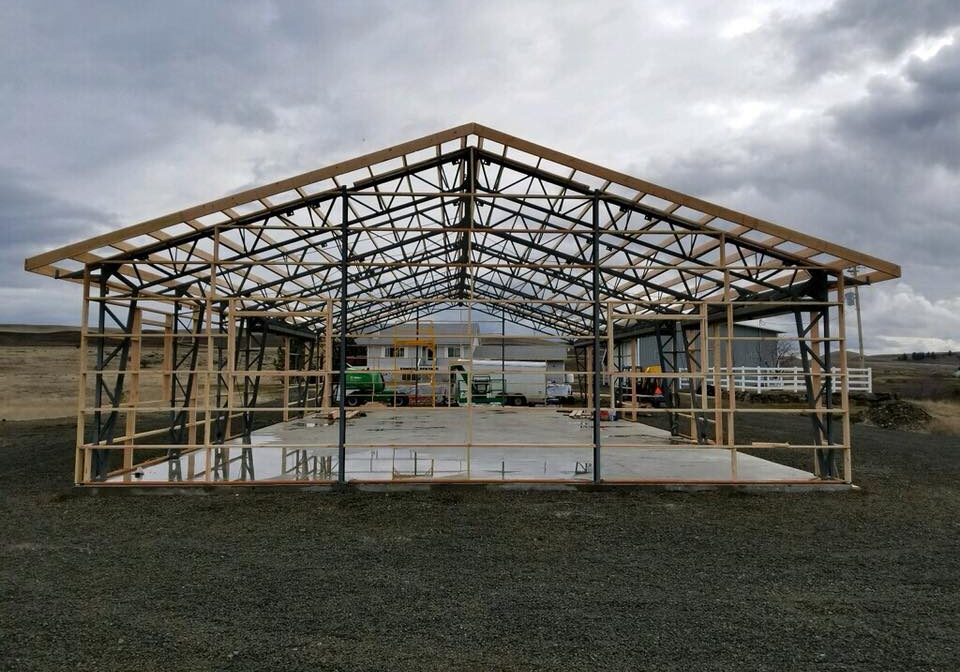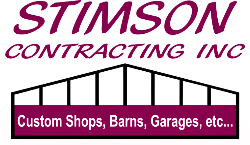
How to Insulate Your Pole Barn for All-Season Use
When you live and build in a four-season climate like Spokane’s, insulation isn’t a luxury—it’s a necessity. Whether your pole barn is a garage, workshop, hobby space, or even a full-time residence like a barndominium, it needs to be comfortable, energy-efficient, and protected year-round.
At Stimson Contracting, we’ve helped hundreds of clients insulate their post-frame buildings to handle Spokane’s cold winters, hot summers, and everything in between. In this article, I’ll break down the best strategies, materials, and tips for insulating your pole barn for all-season use—without overcomplicating or overpaying.
Table of Contents
1. Why Insulation Matters in Pole Barns
Unlike traditional homes with layered framing, pole barns have large open cavities and wide spans. Without proper insulation, that openness can quickly become a liability:
Winter: heat escapes and condensation forms
Summer: buildings overheat and sweat
Year-round: energy bills skyrocket and comfort plummets
Good insulation turns your pole barn into a year-round workspace, living space, or storage area.
2. Understand Your Building’s Purpose
Before choosing an insulation system, ask yourself:
Will the space be heated, cooled, or both?
Is it for full-time use or seasonal use?
Are you adding plumbing or HVAC systems?
Will people be living or working inside for long hours?
Your building’s function should guide the insulation investment.
3. Common Insulation Options for Pole Barns
Here are the most common types we use on pole barn builds in the Spokane area:
Batt Insulation (fiberglass or mineral wool): Affordable and accessible, but requires careful installation.
Spray Foam Insulation: Excellent air sealing and high R-values, perfect for irregular cavities.
Rigid Foam Board: Great for walls or ceilings, especially under metal siding.
Blown-In Cellulose: Sometimes used in attics or finished walls for retrofit work.
4. Spray Foam vs. Batt Insulation
Spray foam (especially closed-cell) is ideal for pole barns that need maximum performance:
✅ High R-value per inch
✅ Creates a moisture barrier
✅ Reduces drafts and air loss
✅ Bonds to metal panels
Batt insulation is a more budget-friendly choice and works well if you’re framing out interior walls.
5. Don’t Forget the Roof and Ceiling
Heat rises—so the roof and ceiling are critical to insulate properly:
Use blown-in or batt insulation in attic spaces
Add spray foam under the roof deck if exposed
Include vented ridge caps and eaves to allow airflow
Proper roof insulation makes the biggest difference in year-round comfort.
6. Air Sealing and Vapor Barriers
Insulation only works when it’s paired with effective air sealing and vapor control:
Tape all seams
Use vapor barriers on the warm side of insulation
Seal around windows, doors, and electrical penetrations
This prevents condensation, mold, and heat loss—especially in winter.
7. Insulating Slabs and Foundations
If you’re pouring a concrete slab, you’ll want to consider:
Rigid foam board under the slab or around the perimeter
Vapor barriers to stop moisture wicking
Radiant floor heat for comfort and efficiency (optional)
Cold floors are a common complaint in pole barns—slab insulation solves it.
8. Ventilation: The Secret to Moisture Control
Good insulation traps warmth. Without ventilation, it can also trap moisture.
Ridge vents and gable vents help move hot, moist air
Mechanical ventilation is ideal for livable spaces
Eave vents maintain airflow and reduce condensation
A well-insulated building without ventilation is a recipe for mold and structural issues.
9. Energy Efficiency and Code Compliance
In Spokane County, insulated pole barns used as living or working space must meet Washington State Energy Code standards.
We ensure compliance by:
Meeting R-value requirements
Providing proper insulation documentation
Working with inspectors to pass on the first try
You’ll stay warm, efficient, and legal—without surprises during resale or refinancing.
10. Conclusion: Build Comfort Into Every Season
If your pole barn is more than just a shell, insulation is the key to making it livable, efficient, and comfortable year-round. With the right strategy, materials, and ventilation, your building will stay dry in winter, cool in summer, and cost-effective all year long.
At Stimson Contracting, we design and build pole barns with all-season comfort in mind. Whether you need help choosing the right insulation or want a fully finished structure from the ground up, we’re here to help you build it right.
📞 Call today to schedule a free site consultation 509.244.2636
🌐 Visit our website for Spokane-specific building tips
📧 Request a custom quote and timeline
Read our other articles:
- Home Page
Barndominiums in Spokane: Trendy, Durable, and Affordable
10 Reasons Pole Buildings Are the Future of Rural Construction
How to Choose the Right Pole Barn Contractor
Top Pole Barn Design Ideas for 2025
How to Plan Your Dream Shop Construction Project
What You Need to Know Before Building a Pole Barn in Spokane
The Pros and Cons of Living in a Barndominium
Spokane Shop Construction: Local Regulations to Know
Custom Pole Buildings: Options That Add Value
From Barn to Barndo: The Transformation Process
Spokane’s Growing Demand for Custom Commercial Buildings
Common Mistakes to Avoid with Pole Building Projects
Is a Pole Building Right for Your Small Business?
Why Pole Barns Are Ideal for Rural Spokane Properties
Can a Pole Barn Increase Your Property Value in Spokane?
Multi-Use Shop Buildings: Storage, Work, and More
7 Creative Uses for Pole Barns in Spokane
Exploring the Cost Per Square Foot of Pole Barns
10 Barndominium Myths Debunked
Building a Shop on a Budget Without Cutting Corners
Navigating Commercial Building Codes in Spokane
Turning a Pole Barn into a Livable Space
The Complete Guide to Pole Building Construction in Spokane
What Is a Barndominium and Why Should You Build One?
Shop Construction Mistakes to Avoid
Cost Breakdown: Building a Barndominium in 2025
Post-Frame vs. Pole Barn: What’s the Difference?
Spokane Area Shop Construction: Timeline Expectations
What Makes a Barndominium So Cost-Effective?
Top 5 Mistakes to Avoid When Building a Pole Barn
Tips for Constructing a Durable Warehouse
How to Insulate Your Pole Barn for All-Season Use
